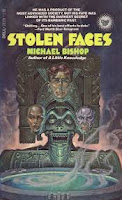The perception of Aztec and Mayan cultures is often of a war-like, bloodthirsty people who made ritual sacrifice quotidian. While there is historical evidence in support of this image, it doesn't paint the full picture. Slaves and prisoners weren't the only people sacrificed. The belief was that blood offerings forestalled the end of the world, meaning many people voluntarily offered their lives—people who wanted their heart removed, body disfigured, and ultimately death in the name of the cause. Examining this phenomenon in a science fiction setting is Michael Bishop's superb Stolen Faces (1977).
Stolen Faces is the tragic story of Lucian Yeardance. After a personal conflict with a commanding officer, Yeardance is exiled to Tezactl and assigned the title of Commissar of the planet's leper colony. A difficult situation, Yeardance has only a small group of assistants to help manage the colony and supplies are limited, often not being delivered to their remote outpost on time. Exacerbating the situation is the fact the colony has devolved into near animalhood. The younger, healthier lepers torment and steal from the older, more debilitated ones, and a bizarre system of beliefs induce the people into sadomasochistic behavior. Getting to the bottom of the situation proves to be the opposite of what Yeardance expects.








